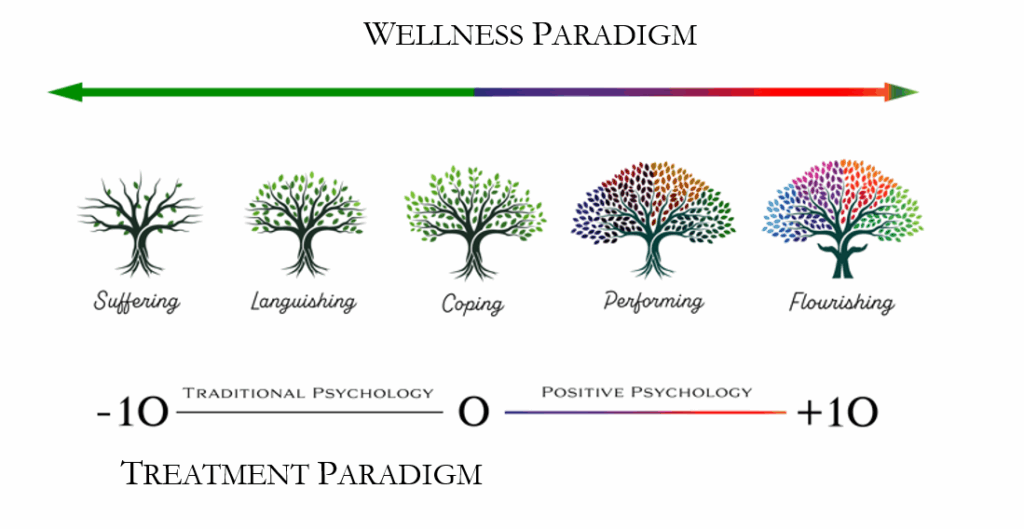Flourishing with Chronic Illness: 6 Wellness Pathways for Entrepreneurs
September 16, 2025
When I was diagnosed with rheumatoid arthritis (RA), I thought wellness was something I might have to give up, or at the very least, felt completely out of reach.
After all, wasn’t illness the opposite of wellness?
But what I’ve learned is this: illness and wellness are not opposites. Opposites tell us that something is either/or. Instead, I like to think of illness and wellness as compatible paradigms. Even partners! When we focus on both together, we open the door to something far more powerful – flourishing!
The Illness–Wellness Paradigm: Rethinking Illness and Wellness Together

When we talk about health, the focus often begins with what’s wrong. What’s broken? What needs to be treated or fixed?
And while those conversations are valid and necessary, they’re also incomplete. Our health is much bigger than what’s wrong. It’s also important to focus on what’s right and capitalize on building more of that.
Most of us are taught to think of health as binary: you’re either sick or you’re well. But anyone living with chronic illness knows it’s not that simple.
There’s a model I refer to often in my own life and work called the Illness-Wellness Continuum (originally developed by Dr. John Travis). Picture it like this, in relation to our lives with chronic conditions:
- On one side, health declines in various stages: flare-ups, stress, exhaustion, inability to move, the days when just “making it through the day” feels monumental.
- In the middle is coping: the neutral zone where you’re functioning and you are doing OK, but just barely.
- On the other side of the continuum, there are degrees of wellness: moments when, even with illness, you find ways to feel engaged, energized, connected, and purposeful.
Here’s the part that changed everything for me: you can still focus on your wellness and move toward flourishing even while managing chronic illness.
Wellness isn’t found when illness is erased or “better”. It’s about pairing a wellness paradigm and focus, while also focusing on treating an illness paradigm. They are not mutually exclusive, and in fact they work best when paired together.
Six Pathways to Flourishing with Chronic Illness → Six Pathways Chronic Bosses Can Use to Flourish
Positive Psychology provides us with a framework for this wellness paradigm. Often referred to as, the science of human flourishing, Positive Psychology provides us tools, skills, and evidence-based practices that support our wellbeing. Positive Psychology provides decades of research showing what helps humans thrive. These six pillars can be especially powerful for women balancing ambition with chronic conditions:
- Positive Emotions
Cultivating emotions like gratitude, hope, joy, and compassion, while learning to understand and work with difficult emotions. These help us build resilience and broaden our perspective.
What it looks like for Chronic Bosses: Practicing gratitude for what your body can do, finding small joys in a flare day, or savoring moments of relief.
- Engagement
Finding activities that draw us in fully, often called flow, where we lose track of time because we’re so immersed. Knowing and using our strengths to stay present and energized in work and life.
What it looks like for Chronic Bosses: Designing work to align with your strengths and your energy levels so that even when you might not be at peak performance, you’re working in your “zone.”
- Relationships
Developing meaningful, authentic, supportive connections. Healthy relationships are one of the strongest predictors of wellbeing.
What it looks like for Chronic Bosses: Building a trusted circle who gets it: family, friends, colleagues, or fellow Chronic Bosses who understand your reality.
- Meaning
Living with purpose. Connecting our actions to something bigger than ourselves, such as service, spirituality, or legacy.
What it looks like for Chronic Bosses: Connecting your career goals to a deeper purpose. For me, RA became the catalyst for launching my business, helping others to better understand the science of wellbeing and ways to flourish.
- Achievement
Setting and working toward goals that matter to us. Progress, learning, and accomplishment fuel motivation and pride.
What it looks like for Chronic Bosses: Setting ambitious yet flexible goals. Sometimes it’s running a team meeting; other times it’s simply honoring your body’s need for rest and be off camera during meetings for a full day. Both count.
- Vitality
Caring for our physical, emotional, and mental energy. This includes rest, movement, nutrition, and stress management, and is the foundation for everything else.
What it looks like for Chronic Bosses: Prioritizing rest, movement, nutrition, and boundaries. Vitality isn’t about perfect wellness, it’s about protecting the energy you have.
Why This Matters → Flourishing Is Possible (Even with Chronic Conditions)
Thriving with chronic conditions isn’t about pretending the hard stuff isn’t there. It’s about learning to flourish alongside it. Your ambition doesn’t have to be sacrificed; it just must be supported differently.
So, I’ll leave you with this:
- Where are you right now on the Illness–Wellness Continuum?
- Which of the six pillars could you lean into this week to move one small step closer to flourishing?
I’d love to hear from you. Where do you see yourself on the Illness–Wellness Continuum today? Drop a comment or share your reflection so we can continue learning from each other as Chronic Bosses.
Because you deserve more than “just coping.” You deserve to thrive and there are tools to help us get there! I can’t wait to share more about all of this in upcoming columns!
By: Laurie Butson, Cleared to Flourish, LLC
